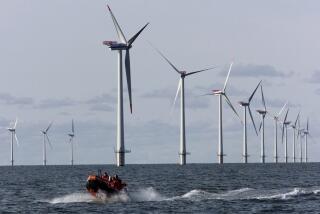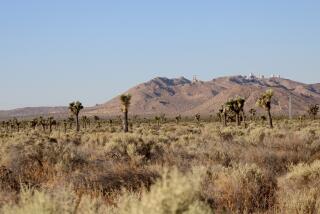Palmdale in a Spin Over Windmill Plans
- Share via
Palmdale water officials had hoped a giant wind turbine would be towering over this high desert city by now, its graceful, rotating blades churning out smog-free electricity in a moving testament to environmental foresight.
It was supposed to be a novel and responsible way to power a water treatment plant. But winning over the neighbors has hardly been a breeze.
Residents are appalled that a space-age contraption best known for dotting desert highways near Palm Springs and Tehachapi is being proposed near the scenic gateway to their booming city of 121,000 people. The turbine could be up to 320 feet tall, and homeowners have called it a “monster” that would ruin the sweeping views of the Antelope Valley on the main approach from Los Angeles.
The locals know that some scoff at the notion that Palmdale, with its auto lots and dun-colored tract homes, has any beauty to spoil. Homeowner Nicholas Teeter contends that the turbine will only fuel more snobbery.
“Putting it dead center in the view from the Highway 14 overlook will bring great joy to our neighbors to the south who love to make fun of the ‘ignorant hicks’ that are stupid enough to live in the Antelope Valley,” he wrote in an e-mail to the Palmdale Water District.
In December, city officials filed a lawsuit demanding that the water district subject the project to a full environmental review. The suit, which has stalled the project for now, raises a number of objections, but the larger battle turns primarily on questions of aesthetics: Would the massive thing be a symbol of pride that celebrates eco-friendly civic values? Or would it be a laughable blight on this edge city, an eyesore evoking, as one resident put it, “gigantic mechanized industrialization”?
Palmdale is not the only community pondering how a 30-story pinwheel might change its character. Similar debates are cropping up elsewhere in the United States as the resurgent wind-power industry introduces windmills and larger “wind farms” closer to densely populated areas.
“The industry is growing to the point where we want to install these towers in places where people will actually see them,” said Kathy Belyeu, spokeswoman for the American Wind Energy Assn., a Washington, D.C.-based trade group. “The question of whether communities will want to have them is going to become a big one.... [But] communities aren’t aware that clean air is what’s in the balance.”
After an initial wave of interest in wind power in the 1970s and ‘80s -- much of it in California -- the industry was hobbled by mediocre technology and dubious tax schemes, Belyeu said.
But more-efficient machines and retooled state and federal tax incentives have spurred a new surge of wind-power projects across the country. In the last two years, wind energy-generating capacity has nearly doubled in the U.S., with turbines now producing a total of 4,685 megawatts, enough to power 1.3 million homes, according to industry estimates.
A Pennsylvania energy company is planning a five-turbine wind farm just outside Atlantic City, N.J., that would be visible from the city’s expressway. A small college in St. Paul, Minn., is planning to erect a turbine, to the chagrin of some neighbors. And the Northeast’s chattering classes are bitterly torn over a proposal to install 170 offshore turbines in Nantucket Sound off Cape Cod.
Such controversy has been more common in Western Europe, where such countries as Denmark and Spain have fully embraced wind as a green-power alternative and widely erected turbines.
In England, where the government hopes to derive 20% of its energy from renewable sources by 2020, opponents complain that the encroaching turbines would contribute to visual blight.
One member of Parliament proposed a total ban, calling them “great lavatory brushes in the sky.”
The Palmdale Water District began exploring wind power after being threatened with blackouts during the 2001 electricity crisis.
Half the cost of the $1.2-million turbine would come from a state alternate energy program. The district would also receive rebates when the turbine produced excess energy and pumped it into Southern California Edison’s power system, said Dennis LaMoureaux, the district’s general manager.
The water board approved the project in November on a 4-1 vote. Board member Leslie Carter, who voted for the project, said he was impressed by the looks of the newer, sleeker generation of turbines.
“I don’t think they’re ugly -- I think they’re kind of neat-looking,” Carter said. “The day is coming when we’re going to have to realize that we have to utilize all of our natural resources. And the wind up here is one of those resources.”
The city, in its lawsuit, argues that the turbine is dangerously close to the San Andreas fault -- less than half a mile away.
It also raises questions about the effect on local endangered birds such as the bald eagle. The blades of the turbine, the suit contends, could act as an “aerial buzz saw” on diving raptors.
City officials fault the district’s proposed response to this potential problem, which amounts to keeping track of bird carcasses on the ground.
Palmdale Mayor Jim Ledford equates the turbine with the kinds of unattractive public utilities that the city forces developers to install underground. His constituents felt similarly nearly two decades ago, he said, when they successfully fought a large wind-farm project in the nearby Ana Verde Hills.
Ledford and others are also concerned that the single turbine will pave the way for more intrusive wind farms, like the 80-turbine farm the city of Los Angeles is considering a few miles north of the town of Mojave.
Teeter, who has lived in the Antelope Valley since the 1970s, acknowledged that the area has wind to spare but said erecting the turbine could hurt the area’s notoriously volatile housing market.
“If the first thing you see is this giant thing that basically says, ‘The wind blows out here,’ ” he said, “you’re advertising a negative for the whole valley.”
More to Read
Inside the business of entertainment
The Wide Shot brings you news, analysis and insights on everything from streaming wars to production — and what it all means for the future.
You may occasionally receive promotional content from the Los Angeles Times.










